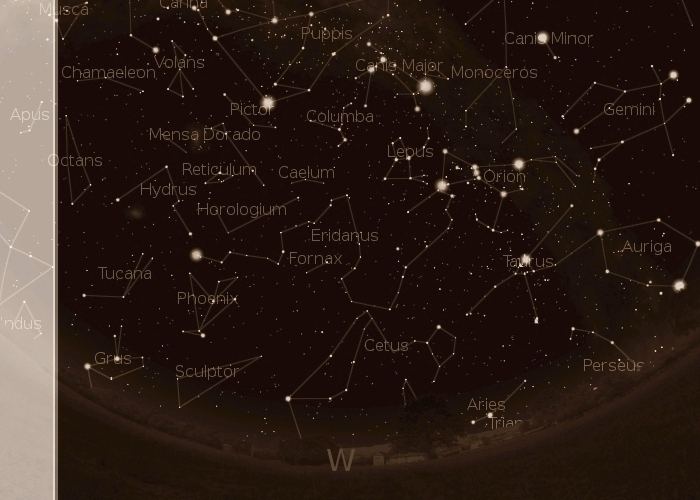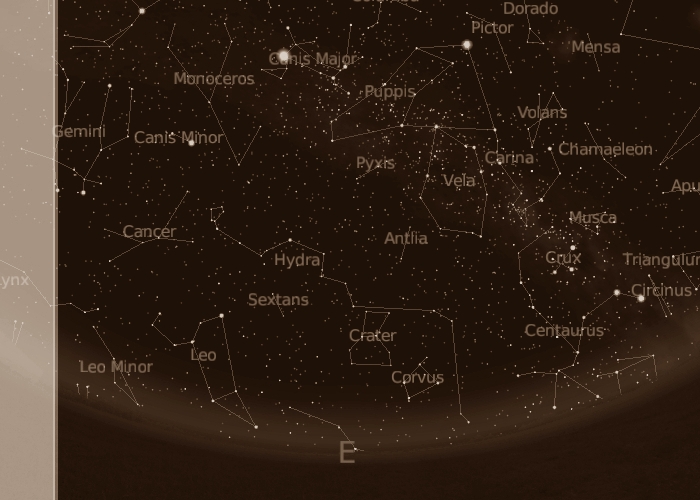Western Horizon
Eastern Horizon
![]()
Western Horizon
Eastern Horizon

It's summer! Like every summer, it's the northern horizon which is of interest, as it's there that one can see the 'great winter sky", that set of fine constellations and bright stars which, in the northern hemisphere, is the typical feature of the winter skies there. Before that, let's turn West! The main show there is Eridanus, the River Eridanus. That celestial river is taking its source at Orion, the Hunter -Orion's star Rigel more precisely- as it's meandering a long way down to the famed and bright Achernar. See it southwest! A fine show! Cetus, the Whale, which is anchored at one bent of Eridanus, is now tending low. The southwestern part of the sky is of interest too, as both the Small and the Large Magellanic Cloud are still high and well observable. Miscellaneous, typical southern constellations are seen too in the neighbourhood, like Reticulum, the Reticle, Horologium, the Clock, or Phoenix, the Phoenix. Fine! to a printer-friendly chart
West for the tropics. West for the mid-northern latitudes

First of all, turn North! It's there, during the southern summer that you can gain access to the 'great winter sky', this set of constellations and stars which is the distinctive feature of the winter nights, North. They are all there, illuminating the sky! The large quadrilateral, high, barely northwest, it's Orion, the Hunter, with those three stars aligned in its center, as, above M42, the famed Orion Nebula is lying! Using Orion like a beacon, let's explore that region! Follow, bottom and left, the line of the three stars. There you find Aldebaran, of Taurus, the Bull, among the V-shaped Hyades. Follow the line up and right this time. Hey! That's Sirius! The sky's brightest star, and the main star to Canis Major, the Great Dog (CMa). Back to Orion, as you consider the line between Rigel -the upper left star of the quadrilateral, and Betelgeuse -the lower right. Follow the line downwards. Here's another quadrilateral. It's Gemini, the Twins. Now follow the entire direction given by Orion, downwards! The bright star, few above the horizon, it's Capella, the bright star to Auriga, the Charioteer. At last, look back to this region between Canis Major and Gemini. The bright star you can spot there, it's Procyon, main star to Canis Minor, the Little Dog. Fine views! Back East, strictly, now! Other great views! The whole southeastern part of the sky is filled by those Milky-Way embedded, typical, southern constellations, ranging from Centaurus, the Centaur up to Puppis, the Ship's Stern! Crux, the Southern Cross has now well risen. Albeit less dense, a row lower in the sky is not devoided of interest either, as the faint chain of Hydra, the Hydra is seen, spanning the sky, and that Cancer, the Crab is northeast. Cancer is home to M44, Praesepe, this fine open cluster, a fine object. Leo, the Lion, at last, is rising. The brightest star here is Regulus, as Leo's Sickle is a fine asterism to spot. to a printer-friendly chart
East for the tropics. East for the mid-northern latitudes
(color maps with Stellarium; printer-friendly charts with Cartes du Ciel, Patrick Chevalley)
Website Manager: G. Guichard, site 'Amateur Astronomy,' http://stars5.6te.net. Page Editor: G. Guichard. last edited: 12/28/2010. contact us at ggwebsites@outlook.com